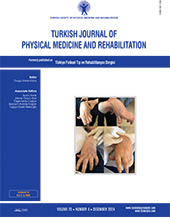Reliability and validity of the Spinal Cord Injury Secondary Conditions Scale among the Turkish population with spinal cord injury
Patients and methods: After the translation/validation process, the SCI-SCS was administered to 93 patients (69 males, 24 females; mean age: 47.9±14.3 years; range, 18 to 78 years) with SCI, diagnosed according to the American Spinal Injury Association impairment scale (grades from A to D), with at least one year after the injury, recruited between December 2022 and July 2023. Fifty-seven patients rated the SCI-SCS two to three days apart to investigate the test-retest reliability. Correlations between the first rates of the SCI-SCS and the Spinal Cord Independence Measure III (SCIM-III), Spinal Cord Injury Spasticity Evaluation Tool, Penn Spasm Frequency Scale, 36-item Short Form Health Survey (SF-36), Beck Depression Inventory, Beck Anxiety Inventory, and the pain-DETECT questionnaire were investigated for the evaluation of convergent validity.
Results: There were 65 patients with paraplegia and 28 patients with tetraplegia. The SCI-SCS showed good internal consistency (alpha=0.753). The three-factor model demonstrated a good fit to the data (relative chi-square=1.12, comparative fit index=0.981, Tucker-Lewis index (TLI)=0.977, root mean square error of approximation=0.037, standardized root mean square residual=0.120). The testretest reliability was excellent, with an intraclass correlation coefficient of 0.79 (95% confidence interval 0.67-0.87). There were statistically significant correlations between the total SCI-SCS and all other administered questionnaires, except for the social function, emotional, physical, and general health domains of SF-36 and the self-care, total, and mobility subscales of SCIM-III.
Conclusion: The study demonstrated that the 14-item SCI-SCS represents a valuable scale for the assessment of secondary conditions among the Turkish population with SCI.
Keywords : Reliability, secondary health conditions, spinal cord injury, validity

















